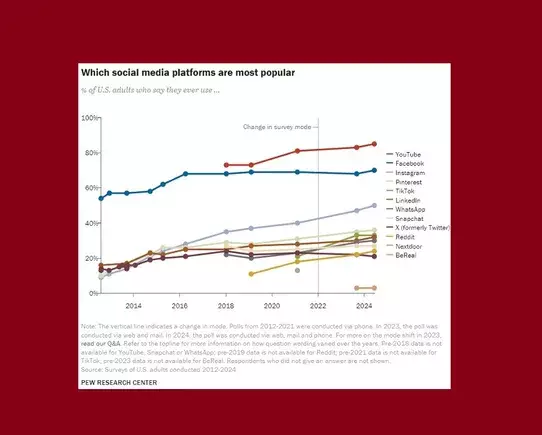Social media continues to evolve, presenting new challenges and opportunities for users, businesses, and marketers alike. Recent findings from Pew Research provide an insightful glimpse into the latest trends in social media usage among U.S. adults, particularly highlighting the waning relevance of certain platforms like X (formerly Twitter). As we dive deeper into these findings, it’s crucial to understand what they signify for the social media ecosystem at large.
According to the Pew Research survey, which analyzed the responses of 5,626 U.S. adults between February and June of this year, YouTube and Facebook stand out as the leading social media platforms. YouTube, often debated as a true social network due to its primary focus on video consumption rather than interaction, garners significant attention, much like Facebook, which remains a staple among older demographics. This dynamic presents a fascinating paradox; despite being less social in nature, YouTube has carved out a space as a dominant player in the social media landscape simply by virtue of its content consumption model.
Facebook, often criticized for its declining appeal among younger users, still commands a loyal user base among older adults. This trend may be attributed to the platform’s integration of various features over the years, including groups and marketplace capabilities, which appeal to older users seeking community and commerce online. However, the data suggests that, while these platforms maintain high user engagement levels, the rise of alternatives like TikTok and Instagram cannot be ignored.
Interestingly, the usage statistics from Pew Research indicate a plateau in TikTok’s growth over the past year. Despite the app’s unique format encouraging longer viewing times compared to traditional social networks, it appears to have reached a level of consistent saturation among users. Conversely, Pinterest is experiencing a resurgence, marking a shift toward visual inspiration rather than traditional social interaction. This shift opens up discussions about the type of content that resonates with different age groups and demographics, indicating that users are seeking varied experiences across platforms.
While TikTok’s user engagement remains high, it is noteworthy that Snapchat’s usage has held steady. This stability raises questions about Snapchat’s long-term relevance as users increasingly flock to more visually dynamic platforms like TikTok. As the younger audience gravitates toward these platforms, marketers must reconsider their strategies to effectively reach this demographic.
Perhaps one of the most significant takeaways from the report is the subtle decline of X, formerly known as Twitter. While the drop in active users is not as dramatic as some had anticipated, it raises red flags regarding the platform’s ability to retain relevance. Given X’s emphasis on real-time interactions and text-based content, this gradual decline could suggest that users are seeking more engaging and visually stimulating experiences.
Notably, X’s alternative audience profile contrasts sharply with younger users flocking to TikTok and Snapchat. As this demographic trends towards platforms that offer quick video content and interactive narratives, X’s future remains uncertain. Understanding these shifts will be pivotal for individuals and brands seeking to leverage social media for outreach and engagement.
As we analyze the current state of social media, it becomes increasingly clear that different platforms cater to distinct audience segments. Facebook’s elder user base, along with YouTube’s broad appeal across generations, set the stage for strategic planning in 2025. For businesses and content creators, aligning their strategies with these trends is crucial. Targeting the right demographic on the right platform can mean the difference between successful engagement and being lost in the overcrowded digital space.
The landscape of social media is in constant flux, and understanding the underlying trends is critical for anyone looking to navigate this dynamic environment. From the enduring dominance of YouTube and Facebook to the emerging prominence of TikTok and the wavering relevance of X, the insights gained from recent research serve as a valuable resource for shaping future social media strategies. As trends continue to evolve, staying informed will be key to maintaining a meaningful online presence.


Leave a Reply